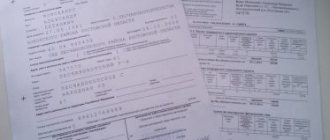Home / Labor Law / Payment and benefits / Wages
Back
Published: March 16, 2016
Reading time: 8 min
0
5457
The wage fund includes all types of payments made to employees of the enterprise for a certain period of time from the enterprise budget. These are wages, bonuses, allowances, compensation.
Correct fund calculation is necessary at all stages - both in the process of planning investments and profits, and subsequently for basic financial forecasts and reporting. For this, there is a special formula into which the relevant data is substituted; the efficiency of the enterprise depends on the correct calculation.
- What does the fund consist of?
- Fund structure
- What data will be required for the calculation?
- Calculation procedure Annual
- Monthly
- Day
- Essential workers
Payroll fund - what is included in this concept and how is it different from the wage fund?
The two funds (wages and salaries) are interconnected, but are not identical.
Although the coincidence of these indicators is possible when a company saves on various types of payments (social and other) to its employees and, in addition to direct remuneration for labor (salaries), does not provide any other payments. Every company manager and individual entrepreneur must have an idea of what the wage fund includes. Based on the theoretical aspect, the wage fund (WF) is the totality of a company’s funds (both in cash and in kind) spent over a certain period of time on payments to the workforce.
First of all, the payroll includes salaries and bonuses, as well as various additional payments (for part-time work, for work at night, etc.). The listed elements are followed by incentive and compensating components of the payroll, as well as other payments (for example, accrued for time that is not worked, but is legally subject to payment). In general, the payroll includes the wage fund (WF), social and other payments.
The wage fund is a narrower concept than payroll, but both funds are formed and calculated using similar algorithms. We'll talk about this in the following sections.
Payments not included in the salary package
Payments are not included in the federal wages (clause 88, clause 89 of the appendix to Order No. 711):
- social nature (their amount in form P-4 should be shown separately);
- expenses that are not related to either the wages or social benefits (they are not reflected in the P-4 form).
Composition of social payments
- Severance pay (including accrued to employees who have already resigned), payments made during the period of subsequent employment, other compensation paid upon dismissal according to law.
- Payments established by the employer upon retirement and dismissal, additional payments to pensioners who continue to work.
- Premiums and contributions paid to employees under voluntary insurance contracts.
- Payments for services of medical institutions (except for those arising during mandatory medical examinations), including prosthetics.
- Payment for sanatorium-resort treatment, recreation, excursions, travel, sports activities is carried out from the employer’s funds.
- Payment for subscriptions, communication services, and parking intended for personal needs of employees;
- payments for the services of preschool institutions and entertainment events held for the children of employees.
- Compensations for damage caused to health (except for those paid at the expense of the Social Insurance Fund) and moral damage.
- Payment (compensation) for travel expenses of the employee and his family members.
- Financial assistance issued for medicines in connection with family circumstances, on the occasion of the birth of a child or funeral.
- Payments for training of an employee that is not related to production needs, and members of his family.
- Compensation accrued for early termination of parental leave.
- Material assistance to trade union members and non-scheduled employees.
- Payments accrued to employees of government agencies upon initial employment.
Expenses that are not related to either the wages or social benefits
- Mandatory insurance contributions paid to extra-budgetary funds, and payments made from the funds of these funds.
- Payments for sick leave made at the expense of the employer.
- Contributions to voluntary pension insurance and payments made from these funds.
- Receipts from insurance organizations related to personal, property and other insurance.
- Income of individuals from participation in organizations as participants, founders, members of the board of directors.
- Royalties.
- The cost of free uniforms that remain with the employee and personal protective equipment, as well as compensation for this cost.
- Travel expenses and field allowance:
- Costs of recruiting workers, relocating them to another area and settling them down.
- Entertainment expenses (without translation services).
- Compensation for the use of personal property for business purposes.
- Compensations paid to persons both employed in the Far North and equivalent regions, and those leaving these regions due to dismissal.
- Costs for obtaining passports and visas.
- Expenses for training and retraining of employees made according to production needs.
- Payments and compensations due to women on maternity leave and persons caring for a child under 3 years of age (except for the situation of early exit from parental leave).
- Monetary allowance for military personnel, paid during the period of service (except for those entitled to persons with special ranks).
- Payments in favor of persons who are not employees (non-working pensioners, family members of deceased employees).
- Scientific state scholarships and payments to individuals made through grants.
- Loans issued to an employee and the benefits of saving on interest.
- Subsidies provided for the purchase of housing, and funds allocated to repay loans taken by the employee for the same purposes.
- The cost of housing provided to an employee free of charge or with partial payment.
- Payment by social security authorities for housing and utilities to workers in the healthcare and education sectors.
How to calculate payroll: formula for calculating the balance
What does the wage fund include and how to calculate it correctly? This question is relevant for all businessmen - the salary component of the cost of goods or services often constitutes a significant share of it and affects the final financial result of the company.
Excessive savings on the payroll amount are fraught - meager salaries, lack of incentives and compensation payments do not contribute to high production indicators and obtaining decent profits. The result of such tight-fistedness of a businessman can be staff turnover, low labor productivity, the desire of individual team members to make up for the amount of remuneration received for work at the expense of the company’s property, etc.
The formula for calculating payroll is the sum of its various components. The number of elements of such a formula depends on the content of internal local acts. For example, if these documents provide for monthly payment to employees of wages (W), bonuses (PR), as well as financial assistance (MA) in addition to vacation pay (WTP), then the formula for calculating the payroll will look like this:
PHOT = Salary + PR + OTP + MP.
The algorithm for calculating the wage fund, the formula of which is presented above, is schematic, and the calculation of the payroll (as well as the calculation of the wage fund) in various companies can be carried out according to a more detailed or abbreviated version of the formula, depending on the composition of the payroll and the wages.
When accounting registers are used as a source of information for the formula, the wage fund for a certain period is calculated as follows. The data on the credit of the 70th account (“Settlements with personnel for wages”) is added from the debit of the accounts:
- the 20th, which reflects operations characteristic of “Main production”;
- 25th, where “General production expenses” are reflected;
- the 26th, reserved for “General business expenses”;
- 08th, where “Investments in non-current assets” are recorded;
- 91st, intended for “Other income and expenses”, etc.
The labor inspector of the State Labor Inspectorate of the Nizhny Novgorod Region, V. I. Neklyudov, explained how to conduct an analysis of the wage fund. Get trial access to ConsultantPlus and find out the official’s point of view for free.
Why is payroll analysis needed?
The role of correct calculation and systematic analysis of payroll is difficult to overestimate, since this indicator allows you to identify shortcomings and adjust the work of the enterprise, with an analysis of costs within individual structural divisions and the entire enterprise as a whole. Fund assessment helps to timely adjust the wage system by changing rates, prices, and salaries.
Contributions to extra-budgetary funds of the Social Insurance Fund and the Pension Fund of the Russian Federation are also calculated based on information about the size of the fund. The actual value of the payroll is represented not only as a way to stimulate workers, but also to rationally distribute the company’s money.
The value of the indicator is influenced not only by internal regulations and the existing remuneration system, but also by a number of legislative acts, so information about the payroll and its calculation is available to any employee of the enterprise.
Payroll is a variable value and subject to adjustment based on the goals set for the organization. The task of those authorized to manage the expenses of an enterprise in order to improve commercial results is to monitor dynamics, identify deviations from planned figures, and make decisions taking into account the identified discrepancies.
The indicator, analyzed over a certain period of time, allows us to compare the dynamics of payroll growth with an increase in productivity and company profit. Information makes it possible to create reserves for various changes in relation to wages and other areas related to the activities of the enterprise.
To make it more convenient to carry out the analysis, sometimes the fund is divided into fixed expenses (salaries, additional payments, vacation) and a variable part (payment of piece workers).
What is included in the wage fund: its composition and structure in the balance sheet
The wage fund is one of the elements of the payroll, which is the amount of funds expressed in monetary form intended to pay wages to members of the workforce.
The composition of the wage fund, as well as the composition of the payroll in general, largely depends on the intra-company structure and the content of local “salary” acts (provisions on wages, bonuses, etc.). In addition to payments - remuneration for labor (at tariffs and rates), the wages and salaries include bonuses, rewards and incentive payments.
There are 4 main components of the FZP:
- direct salary;
- payment for unworked time (vacation, downtime, etc.);
- incentive payments (bonuses, bonuses for length of service, etc.);
- “supporting” payments (free or partial compensation to workers for food, utilities, fuel, etc.).
The structure of the FZP balance sheet varies from company to company. For example, the structure of the “salary” fund of a small consulting firm may look like this:
Total payroll – 100%, including:
- administration – 35%;
- consultants – 40%;
- accounting – 15%;
- technical personnel – 10%.
With regard to the formula for calculating the payroll, the same algorithms and approaches are used as for calculating the payroll described in the previous section.
The wage fund, like the payroll fund in general, requires a scrupulous and attentive approach, so self-respecting companies regularly draw up estimates of the “salary” fund, and also engage not only in its planning, but also in regular analysis. We'll talk about this further.
What is this?
The total wage fund is understood as the totality of the money supply, which simultaneously includes several items:
- The amount for payment of basic wages for both hours worked and not worked.
- Incentive allowances, bonuses, additional payments for a certain type of work that is not part of the employee’s main responsibilities.
- Compensation due to difficult working conditions, changes in work hours or changes in working conditions at an enterprise or in any other organization.
- One-time one-time bonus payments or incentives to certain categories of employees.
- Payments for food, fuel, and housing.
- Also the entire set of social benefits, which is also included in the wage fund. This includes vacation pay, sanatorium and resort pay, health benefits, travel allowances, various types of benefits, with the exception of those paid from state or non-state budgets.
When it is generally clear what the wage fund is, it is necessary to clearly imagine its structure and composition. This will help you understand what funds an employer must spend to maintain a certain number of employees, as well as understand what this fund is made up of and what charges are made from it.
What is the payroll estimate?
The main purpose of the payroll budget is the systematic use of “salary” funds. Typically, calculations are made for the year, broken down by quarters or months. From the estimate it should be clear in what areas the funds are spent, as well as the values of the payroll components.
A separate breakdown of “salary” expenses is made by employee categories (administration, main production personnel, etc.). This allows you to control the use of funds and use the necessary “salary” information for internal planning purposes.
The estimate can be drawn up not only for the main elements of the wages, but also for payments of a social nature and others.
Payroll estimates are an element of planning that is more typical for large enterprises that employ specialists of the appropriate level and qualifications and maintain approaches to planning from the time of the planned (socialist) economy. In modern commercial structures, this document is less common or has a different name. We'll talk about the planning process in the next section.
Payroll planning
Based on the fact that the wage fund includes a significant share of the company’s total expenses, an important issue is the preliminary (planned) determination of the structure and size of the payroll.
The payroll planning process can be represented by the following algorithm:
- Collect information about the structure of the company, the number of personnel and its movement, data on average salaries, production targets; study the staffing table and internal local acts related to payroll (provisions on wages, bonuses, etc.).
- Predict the average number of personnel for the planned time period.
- Choose a planning structure (decide on the main planning parameters and the level of detail of indicators), draw up an estimate.
- Calculate the payroll, choosing the most acceptable method of calculating it.
Read the internal local acts in the material “Regulations on remuneration of employees - sample 2020”.
The predicted payroll allows for timely analysis and control of its use.
Differences between payroll and wages
Despite the similar formulation between these two indicators, they have one fundamental difference:
- the payroll amount includes the amount of accrued wages and social benefits for a certain time period;
- The wages and salaries include the amount of earnings (salaries, allowances, bonuses, compensation related to working conditions) minus social benefits for the same period of time. That is, all the amounts that are due to the employee for the time actually worked and the work performed.
The difference will be clearer if you give a specific example:
The company accrued 500,000 rubles for November 2021, payments for this month were:
– 300,000 rubles – wages for the period from October 15 to October 31, 2017;
– 130,000 rubles – the amount of accrued advance payment to employees for November 2021.
Thus, the payroll amounted to 500,000 rubles, and the wages and salary amounted to 430,000 rubles.
The two indicators may coincide in value with each other in those enterprises where there is no incentive for employees in monetary terms or any other incentive, and only wages are paid. Then, when planning the current and future expenses of the company, only the payroll is taken into account. It is a broader concept and includes the amounts of all accruals, including the wage fund (WF).
Certificate of monthly wage fund - sample
Commercial structures may need this document in the following circumstances:
- when applying for a loan from a credit institution;
- the bank may request a certificate to confirm the integrity of the company in the sense that the money withdrawn from the account actually goes to pay for labor;
- when carrying out control activities by specialists of the Federal Tax Service or insurance funds.
For structures of budget subordination, this document is mandatory.
The certificate may contain information not only about the amount of the wage fund for the month, but also for another period. Moreover, the document can be drawn up both according to expected indicators and actual payments.
There is no standardized form for this document. We have prepared a template that should be suitable for organizations and individual entrepreneurs, since it includes all the information required in such cases. We offer information about the monthly wage fund on our website.
How to write instructions?
It must be said that the payroll can be either daily or monthly, quarterly, or annual (read more about how the annual payroll and full wages are calculated here). When calculating it, it is necessary to process all types of incentives, bonuses, compensations, rates, official salaries, and tariffs existing in the organization.
Simplified calculation scheme : you need to sum up the wages of all employees with a salary and multiply the amount by the number of months of the time period for which calculations are made, for example, by a year, i.e. multiply by 12.
Payroll can be calculated for any period, even for a day .
If the organization has hourly , then we determine the number of working hours. Then we sum up the hourly rates of workers and multiply by the total number of working hours.
For workers with piecework wages , prices are multiplied by the volume of planned work. At the final stage, everything is summed up, and the allowances, compensations and social benefits existing in the organization are added.
Read more about wages and salaries here.
Our specialists have also prepared other materials about payroll and wages:
- What is the efficiency of using the wage fund and how can it be increased? How can one increase the wage fund?
- Proper use and distribution of payroll: what is the variable and fixed part?
- Optimization and cost savings.
- Reflection in the balance sheet and financial statements.
- Basic methods of payroll planning.
- Types of payroll and wages.
- Charges and deductions.
Results
The wage fund includes all payments earned by employees in cash and in kind (salaries, bonuses, compensation, allowances, etc.), as well as social and other payments.
The formation of the payroll is carried out taking into account the local “salary” acts in force in the organization (collective agreement, provisions on remuneration, bonuses, etc.).
You can find more complete information on the topic in ConsultantPlus. Free trial access to the system for 2 days.
Table - all payments and transfers are clear
In order not to get confused in the list of mandatory payments assessed by the state on the wage fund of individual entrepreneurs and legal entities, use the simple and convenient table presented below .
| Tax, contribution or payment | Rate (based on the amount charged) | Some nuances |
| Personal income tax | 13% or 30% | Tax residents of Russia pay personal income tax in the amount of 13%, citizens of foreign countries - 30%. |
| Pension contributions | 22% | Pension contributions are also paid by certain categories of foreign citizens, this is due to the status of their presence on the territory of the Russian Federation. |
| Social insurance contributions | 2,9% | This is a standard rate, which can be increased depending on the harmfulness and danger of production. Paid only by legal entities, individual entrepreneurs - only at will. |
| Health insurance | 5,1% | – |
Russian legislation provides for penalties for non-payment of any taxes and mandatory payments.







